In late 2015, having left the demands of corporate work behind, I returned to sailing after an absence of 35-plus years as crew on an Elan 310 fractional sloop, racing as a member of the Royal Brighton Yacht Club on Port Phillip Bay in Victoria, Australia. I quickly started looking around for a suitable sailboat that I could use on non-racing days. To my dismay, I discovered that Australia, unlike the U.K., U.S., and many European countries, offered a paucity of viable craft. Many, if not most, of the available boats ranged from 30 to 50 years in age and, more often than not, required a major overhaul or a dignified burial.
Over the next three years, I took several wrong turns and traveled hours to view duds with more holes than the ridiculous number of zeros in the asking price. But at last, I narrowed my search and settled on looking for a trailerable sailboat. I also knew that it needed to be a boat I could sail on my own with minimal help, if needed, from my wife. In late 2019, I happened upon Bluewater’s Cygnet 20.
The Cygnet 20 originated in 2013 with a brief by Bluewater Cruising Yachts’ founder, David Bradburn, presented to yacht designers Will Hardcastle and Peter Lowe, to create an entry-level cruising yacht at an affordable price, with overnight or weekend accommodation for a couple or family of four. In August 2017, the prototype was launched at the Sydney Boat Show.
The 23′ design was inspired by England’s small traditional gaff-rigged working boats. It evokes the past with its plumb stem and only slightly raked transom, fixed bowsprit, samson post, transom-hung rudder on bronze pintles and gudgeons, classic portholes, and of course, tanbark sails and high-peaked gaff. In just a few years, the Cygnet 20 has become a highly sought-after inland-waterways cruiser across Australia, suitable for both river raids and competition racing; one was even recently delivered to Lake George in upstate New York.
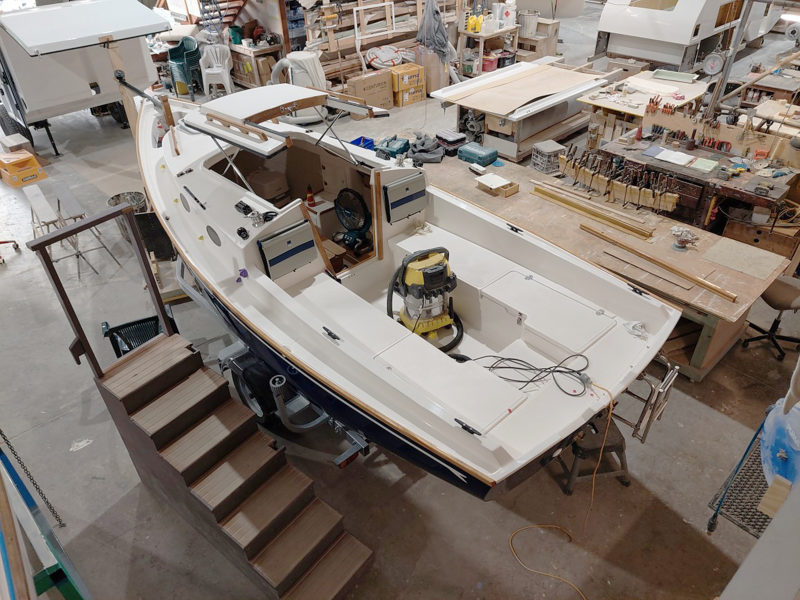 Jan Kent
Jan KentStill in the shop under construction, the lifting coach roof, with its simple expanding cross-struts, is clearly visible. This unusual feature increases headroom, ventilation, and natural light in the cabin.
The hull is built in two pieces. The first, a hand-laid, solid fiberglass molding, incorporates the hull and centerboard case. The second molding, also of hand-laid fiberglass, includes the deck, cabin, cockpit, water-ballast tanks, and interior structures including the berths. The two moldings are joined by an external hull flange at the gunwale, which is capped with a Pacific teak (Vitex) rubrail. Between the rubrail and the coach roof there is a narrow side deck, which provides a secure walkway along the entire length of the boat. The mast, gaff, boom, and bowsprit are carbon fiber and the sails are from Hood Sails in Sydney.
The mast is stepped in a deck-mounted stainless-steel tabernacle supported by a stainless-steel compression post mounted on the keel; it is held in place with a stainless-steel through-pin. The rudder is hung on bronze pintles and is easily removable. The foiled centerboard is of laminated fiberglass with 220 lbs of internal lead ballast. The bowsprit is mounted to the samson post, which acts as a secure mooring bitt.
All surfaces (hull, deck, coach roof, and interior) are offered in Oyster White as standard, but there is a wide range of hull-color options.
The rigging, and most of the deck hardware, is from Ronstan or Harken including jib tracks, jam cleats, mooring cleats, and standing-rigging fittings. The shrouds are U-bolted through the hull-and-deck joint, while the forestay is bolted to the end of the bowsprit, and the bobstay is U-bolted to the stem just above the boot top. Tufnell blocks and Langman cordage are fitted as standard and further complement the traditional look and feel of gaff-rigged boats.
Construction, including all rigging and interior outfitting, is by Bluewater Cruising Yachts who offer various optional items. For example, I chose to add four wooden Pacific teak (Vitex) handrails, a pop-top incorporated with the companionway hatch that includes a color-matched WeatherMAX UV fabric enclosure that features roll-up window covers, bug screens, and complete companionway zip-through access. It allows for full standing headroom below and increases the cabin’s natural light and ventilation.
While the Cygnet 20 is a production boat, that does not prevent the enthusiast from adding their own personal touches. I have added cabin instruments, including a barometer and clock, and a depthsounder, fitted a removable anchor roller, replaced the original sheet bags, and am working on wooden racks for a hand-held VHF, binoculars, and iPad.
 Dairne Lee John
Dairne Lee JohnThe spacious cockpit and high boom offer plenty of comfort for sailing with company, and with a tiller extension and running lines that all lead back to the cockpit, everything is easily to hand for the singlehanded sailor.
The Cygnet 20 has a towing weight of 1,874 lbs. Loaded onto a single-axle trailer, offered by Bluewater, the Cygnet 20 can be towed by most family cars or an SUV.
When the Cygnet 20’s mast is lowered it pivots in the tabernacle, along with the boom, gaff, and both sails, which remain attached, and it is supported on a removable timber boom crutch at the stern. The rig is raised and lowered complete—the sails are bent on, the gaff and boom are attached to the mast, and the furled jib is left in place on the forestay. To rig the boat is straightforward, even for a singlehander: insert the two drain bungs, remove the trailer straps, remove and roll-up the one-piece sail cover, attach the Windex vane to the masthead, loosen all lines and remove any ties, and raise the mast while hauling in the forestay, which is led through a sheave at the end of the bowsprit then back to the cockpit. After the mast comes to a stop—fully upright in the tabernacle—the person doing the hauling walks forward to tie the forestay off at a bow-mounted cleat. Finally, a stainless-steel locking pin is inserted through the tabernacle and mast.
All that remains to be done is to raise the topping lift to free the boom crutch so it can be folded and put away, adjust the shroud tension (if necessary), tidy all lines, hang fenders, give one final check all around, and then launch the boat off the trailer. From start to finish, the boat can be rigged and launched within 30 minutes.
Thanks to the hull profile, the Cygnet 20 can stand upright when dried out. The forefoot is deep and flows into a wide, flat keel plank. With the engine, rudder, and centerboard raised you can run the boat up onto a sandy beach, drop the sand anchor, and camp overnight.
The cockpit features two lazarettes, a deep coaming for good back support and a dry ride in a strong wind, and a nonskid surface throughout that offers surprisingly comfortable seating even without cushions. There is no mainsheet traveler; instead, the mainsheet is led through a 4:1 block-and-tackle system anchored in the center of the cockpit sole. As a result, the cockpit feels uncluttered and spacious and has ample seating for four adults. The starboard lazarette houses the fuel tank for the outboard motor as well as access for the fuel line. The port lazarette houses a hand-operated bilge pump, which is also used to empty the two internal water-ballast tanks, one located beneath (and across) the two quarter berths and the other tank beneath (and across) the cockpit sole aft of the centerboard. Each has a capacity of 63-1⁄2 U.S. gallons, and water is let in via a bronze through-hull and stainless-steel valves. The rear tank, subject to sailing conditions and preferences, can be isolated and not filled; filling the forward tank is a prerequisite before setting off. I found that on light wind days, with four adults on board, the Cygnet was well-balanced with only the forward ballast tank filled to capacity.
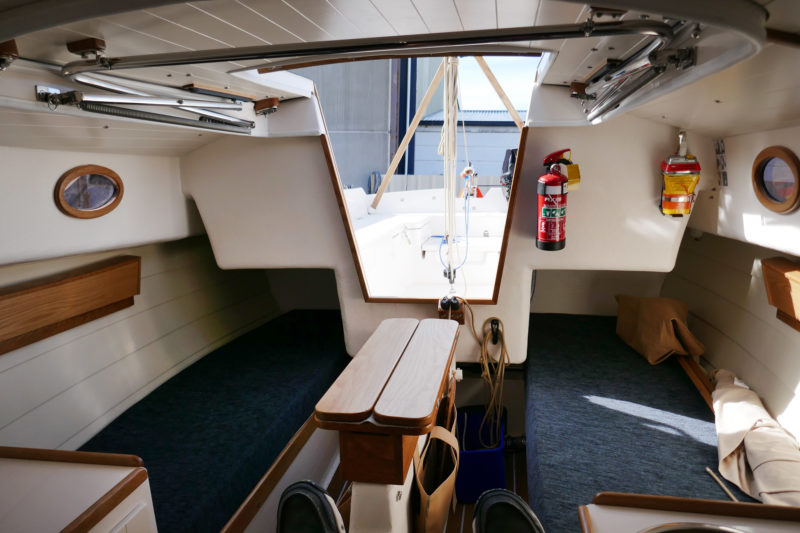 Jan Kent
Jan KentThe two quarter berths are each more than 6′ in length making them suitable for taller crewmembers. The optional folding table sits above the centerboard trunk and provides a useful work surface even when folded away; when extended it is large enough for four people to dine in comfort.
Emptying the tanks requires about 100 strokes for the forward tank or about 150 strokes for both tanks. The system offers ballast flexibility: it can be adjusted according to conditions and crew numbers as well as used to reduce the weight for trailering. When filled, the ballast tanks add about 500 lbs to the overall weight.
Down below, the cabin has four berths. The two settee berths are 6′6″ long and ideal for those who are taller than 6′, while the V-berth in the bow is extremely comfortable for those under 6′. A porta-potti stows beneath the V-berth, while in the main cabin area there is a cupboard and sink to port and a cupboard with benchtop to starboard. An (optional) fold-out timber table, fitted over the centerboard case, provides adequate dining space for four. Lockers beneath all the berths—four under the settees and two under the V-berth—provide plenty of easily-accessed storage. The cabin sides and overhead are finished in V-grooved plywood, but other options are available. The companionway washboards are 7⁄16″ opaque acrylic and can be stowed in two purpose-made bags when not in use.
On my boat, auxiliary power is delivered by a Tohatsu 6-hp four-stroke long-shaft outboard mounted directly to the port side of the transom. (Previously a center motorwell for an inboard-outboard motor was offered, but this has been converted to a locker that can be used as an ice box—just add a bag of ice and your favorite drinks.) My motor can power the boat, with bare poles, up to 5 knots with minimal effort. A connecting arm from the outboard to a tiller provides positive control, in forward and reverse, and can be disengaged when sailing; it is part of Cygnet outfitting. The outboard can be raised out of the water when sailing to reduce drag. The tiller is Pacific teak (Vitex), and the fiberglass rudder blade can be pivoted up above the waterline for beaching and trailering.
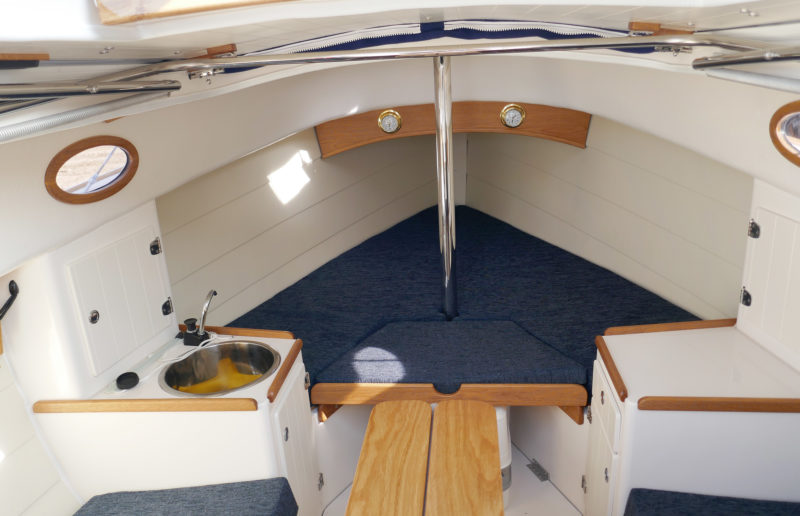 Jan Kent
Jan KentThere is plenty of natural light throughout the cabin, thanks to the portlights, large companionway hatch and, when opened, the lifting coachroof. The forward V-berth conceals a porta-potti and lockers beneath its cushions.
Under sail, movement around the cockpit is easy and the view forward is rarely obscured by the jib. The running lines, including jibsheets, all three halyards—jib, peak, and throat—and the topping lift are led back to jam cleats on the cabintop, within easy reach of the crew. I have added a Ronstan tiller extension so that I can also reach all the lines when helming, taking just one step forward to trim either sail while maintaining complete control of the rudder.
The Cygnet 20 provides a remarkably stable platform that tracks true and holds its course with a very light touch on the tiller. The pivoting centerboard, raised and lowered on a 10:1-ratio winch, allows the crew to bring the center of gravity aft in stronger winds by raising the board 25%, which in turn improves the windward heading. In approximately 10 knots of breeze, Navionics on the iPhone recorded our speed between 5.4 and 6.0 knots. The boat is exceptionally responsive to the helm and easily picks up speed after tacking. There’s no concern when jibing, as the helmsman can easily swing the main across with the mainsheet directly at hand.
The water ballast allows the boat’s center of gravity to be lowered, making the boat both more stable and more comfortable in stronger winds; the relatively short and light rig also contributes to this stability.
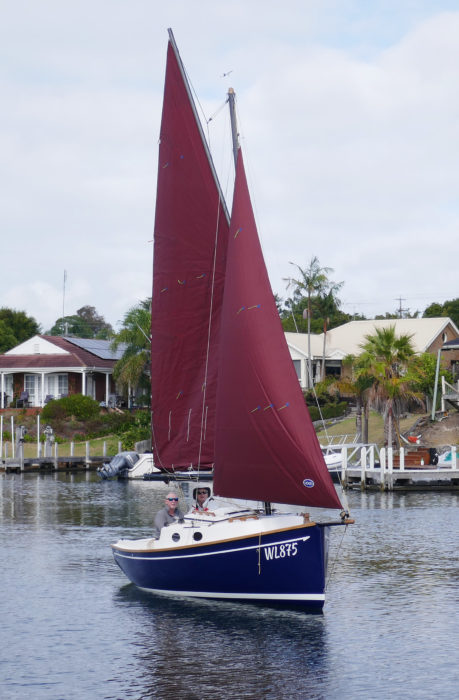 Dairne Lee John
Dairne Lee JohnThe plumb stem, short bowsprit, high-peaked gaff, tanbark sails, and traditional reefpoints clearly reflect the influence of late-19th and early-20th-century British working boats. Less obvious are the modern rigging details that allow one person to rig, launch, and set sail within 30 minutes.
The mainsail has two rows of reefpoints, and with the roller-furling jib there is a great deal of scope for shortening sail as the need arises. Additionally, the gaff-rigged mainsail can be scandalized: by lowering the peak, the sail is almost entirely depowered, and while this is not a good long-term solution for coping with heavy weather, it is a handy trick if you need to reduce sail area quickly and temporarily. A vang delivers control to the boom.
Being designed for inland waterways, the Cygnet 20 does have (some) limitations (well, the only one that comes to mind is that I would not be keen to take it to sea, out of sight of land), but that does not preclude sailing in and around bays, coastal islands, and major rivers that open to the ocean. The versatility of the boat for inland sailing is hard to beat. The Cygnet can be fitted for rowing, complete with sliding seat on tracks set into the parallel cockpit benches, and carbon-fiber oars. When combined with the low height of the rig—just 19′ above the cabintop—and the ability to quickly lower the whole rig even when on the water, this rowing option allows the Cygnet 20 to explore many less accessible rivers and streams, even those crossed by fixed bridges.
I continue to enjoy the boat whatever the season, conditions, or locality, whether I’m cruising with my wife and friends, or just out for an enjoyable daysail on my own. At time of writing, I have booked the next sailing trip inter-state to Tasmania, taking full advantage of having a trailer-sailer that can be ferried overnight (approximately 245 nautical miles). Once in Tasmania, I will be faced with the difficult decision of choosing the first sailing destination from my wish list of about 50 lakes, rivers, bays, and coastal islands.
The Cygnet’s forgiving and well-mannered setup allows a novice sailor to rapidly acquire the necessary skills to enjoy the boat, and there’s more than enough to keep an experienced sailor busy; whether they’re pushing the boat in racing or enjoying some extended overnight cruising. And, for the avid gunkholer, the Cygnet 20 would be hard to pass up.![]()
Jan Stephen Kent is the eldest of three children of Polish migrants who arrived in Australia in the early 1950s. Born and raised in Hobart, Tasmania, his love for the ocean came when he began surfing when he was 14 and has remained with him. He has surfed Peru, Portugal, South Africa, and most of Australia. He has five adult children and three grandchildren. He and his wife have traveled to Peru, Chile, Argentina, southern Africa countries, most of Europe and parts of Asia, and have sailed off Croatia and Sardinia. Set to retire late in 2023, he is still surfing, and messing around in boats has become his passion.
Cygnet Particulars
LOA/19′2-1⁄2″
LWL/17′8-1⁄2″
Beam/7′3-3⁄4″
Draft, centerboard up/ 1′1-1⁄2″
Draft, centerboard down/5′1-3⁄4″
Displacement (loaded)/2,756 lbs
Towing weight (not including trailer)/ 1,764 lbs
Jib/77 sq.ft
Mainsail/176.5 sq.ft
Fuel tank/3 gallons (US)
Fresh-water tank/5 gallons (US)
Required engine size/4hp
The Cygnet 20 is manufactured by Bluewater Cruising Yachts in Cardiff, New South Wales, Australia. The listed price is $72,600 AUS plus GST.
Is there a boat you’d like to know more about? Have you built one that you think Small Boats readers would enjoy? Please email us!
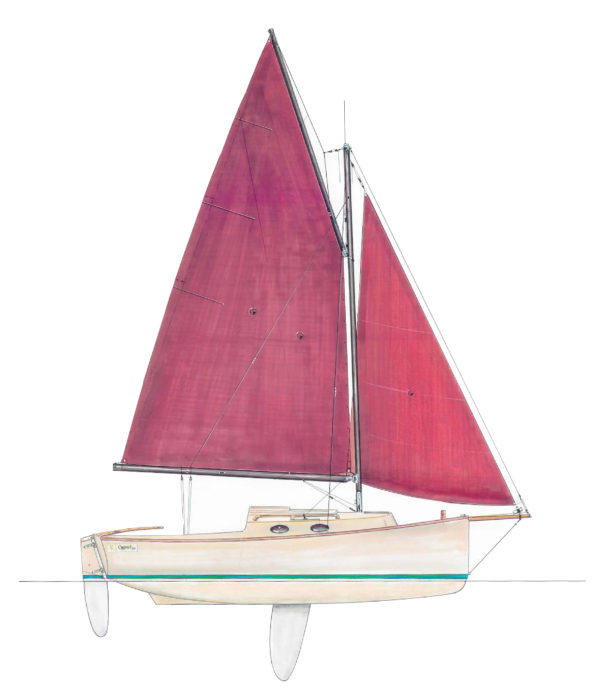
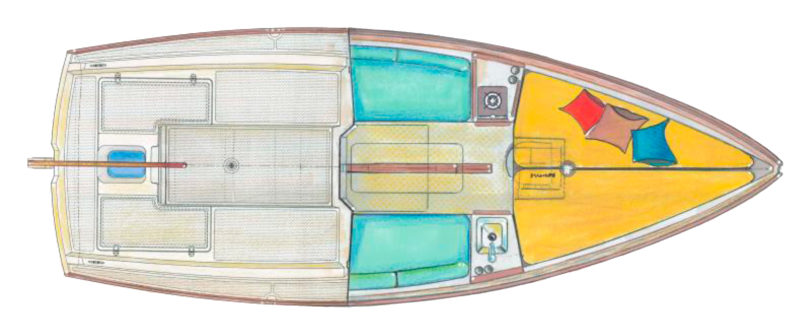
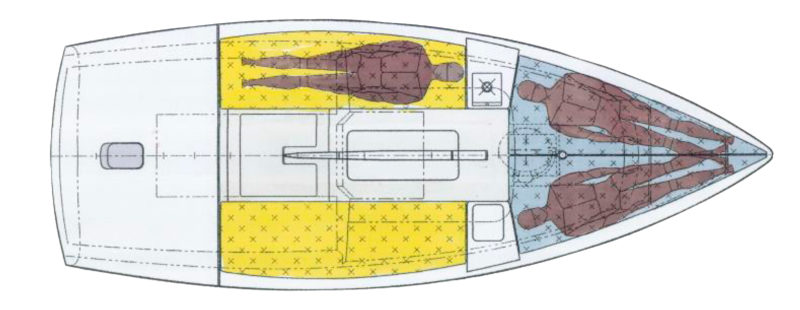


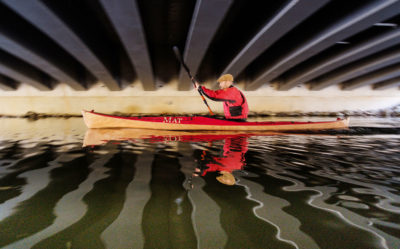
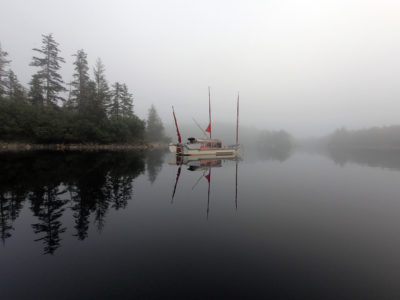
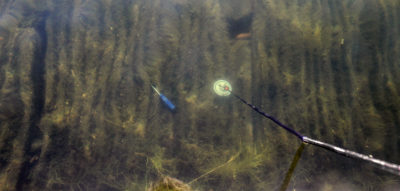
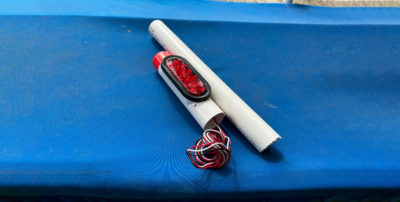
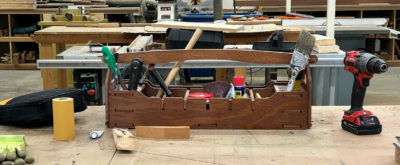


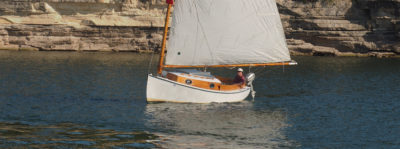
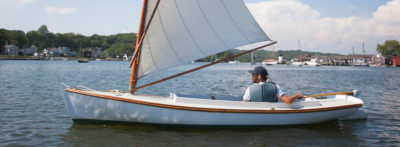

I really like this design and the size is my favorite, easy to trailer and launch, and keep at home and visit many different places. I’m not a fan of the sliding Gunter mainsail rigging, and would consider changing that with recommendations from the designer.